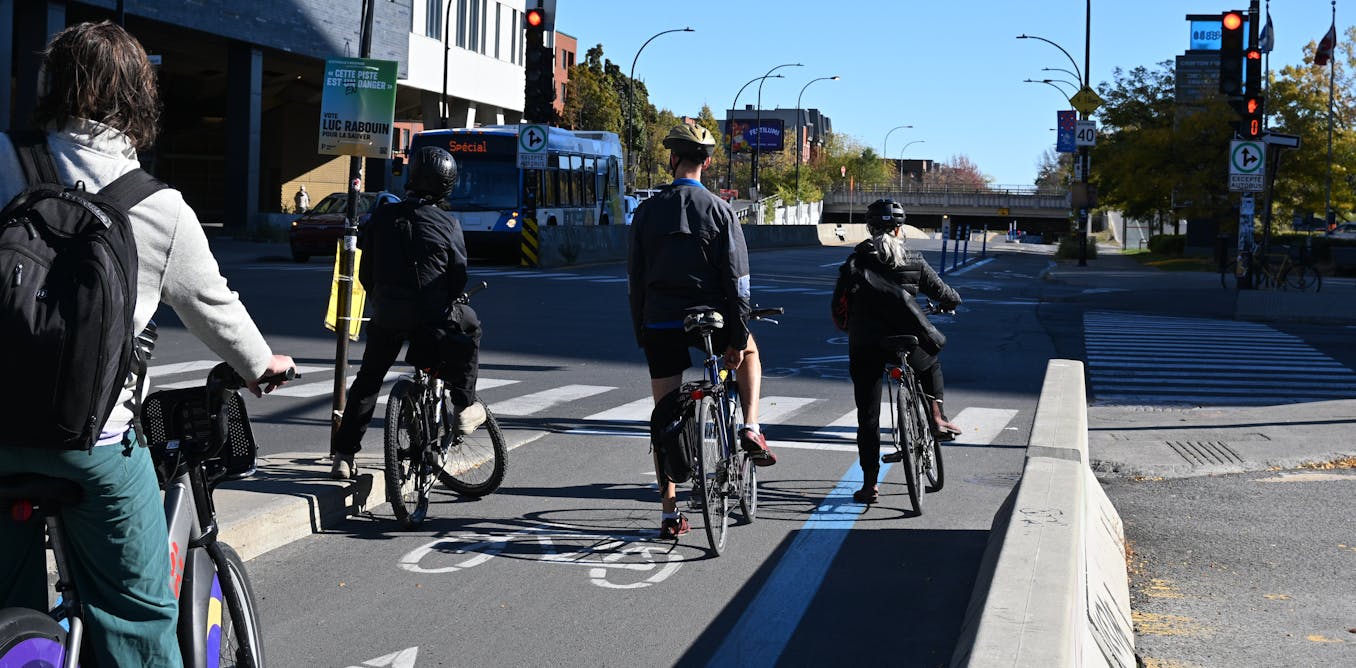The title is a bit clickbait-y. I went into this one feeling strongly opposed it. Afterwards I’m still not sure, but I get that there’s some nuance to it.
Relevance:
In Québec and other parts of Canada, discussions are underway to adopt such regulations.
Author: Steve Lorteau | Long-Term Appointment Law Professor, L’Université d’Ottawa/University of Ottawa
Excerpts:
Interactions between different users on roads are often a source of frustration, the most prominent being those between motorists and cyclists.
For example, many motorists are frustrated when they see bicycles cross an intersection without coming to a complete stop, which drivers are required to do.
As a professor of law at the University of Ottawa who specializes in urban law issues, I have studied various regulatory approaches that have been adopted around the world, each with different advantages and disadvantages.
The uniform application of traffic rules may seem fair, but in reality, it can create a false sense of equality.
On the one hand, the risks associated with different modes of transport are incommensurate. A car that runs a red light can cause serious or even fatal injuries. A cyclist, on the other hand, is unlikely to cause the same degree of damage.
Furthermore, the efficiency of cycling depends on maintaining speed. Having to stop completely over and over discourages people from cycling, despite its many benefits for health, the environment and traffic flow.
Treating two such different modes of transport the same way, therefore, amounts to implicitly favouring cars, something akin to imposing the same speed limit on pedestrians and trucks.
Since 1982, cyclists in Idaho have been able to treat a stop sign as a yield sign and a red light as a stop sign. Several American states (such as Arkansas, Colorado, and Oregon) and countries, such as France and Belgium, have adopted similar regulations.
In Québec and other parts of Canada, discussions are underway to adopt such regulations.
It’s important to note that the goal of the Idaho stop rule is not to legalize chaos on the roads. Cyclists must still yield to cars ahead of them at stop signs, as well as to pedestrians at all times, and may only enter the intersection when it is clear.
Replace most of these:

With those:

Basically (in a city below 50km/hr):
If a car runs a red light, the life at risk is someone else’s.
If a bike runs a red light, the life at risk is their own.
So there is a difference.
I think the lawmakers here are maybe not considering all of the consequences.
Yes a bike won’t be able to cause as much damage to another biker or a vehicle if they don’t stop at a stop sign and then hit one.
Especially when compared to a vehicle hitting another vehicle.
But those aren’t the only two things at a stop sign or intersection. There are also pedestrians crossing the street, often with aight telling them that it is safe to do so. People with disabilities like blindness, people with children, etc.
What happens if there is a line of vehicles to the left of the bike lane blocking the view of the cyclist and they keep going straight since it’s a three way intersection, no road on the right so no vehicles to even worry about, and then a mother with a baby in a carriage steps out from in front of the vehicle at the front?
Sure a bike won’t do as much damage as a vehicle, but it can still certainly do a lot of damage in the right circumstances.
You gotta ask “Why do we need traffic lights?”. The answer is “because of motor vehicles”, so I don’t think cyclists should be disadvantaged by something that is not required because of them.
This whole discussion is a distraction. The real solution is to have proper cycling infrastructure. You don’t need to reinterpret road signs if bikes have their own signs in their own protected lanes and protected crossings.
Bike infrastructure isn’t going to be possible everywhere. Idaho stop makes cycling better everywhere.
I don’t care about “everywhere”. I care about cities where most of the cycling happens.
Permission to exercise discretion does not mean cyclists will blindly roll through danger. No one is more aware of the risk of cycling in traffic than cyclists. Riding defensively is a necessary state of mind. A rule change will have no effect on that.
The unfairness problem imo is a problem because many places don’t have exclusions for bikes. I’m not Canadian so idk if that’s true there.
Both cars and bikes have to obey the rules, even in situations where it is obvious that not obeying them would be better (for example running a red light in the middle of nowhere where you have clear visibility that there are no humans around).
And there are some rules that are obviously thought only for cars, so the bikes think that they can break them.
As a car this is seems as unfair because they can’t break the rules even if they think there’s no danger.
If the rule just says “this rule doesn’t apply to bikes” imho it would be seen as fair-er by cars.
As someone that has been living in Montreal for the past four years, which locale this article brings up numerous times, and biking about 350/365 days a year, I have to highlight a couple things to readers not from Montreal, or maybe even from the other side of the pond:
- Canada doesn’t know what yield signs are. Stop signs are on every corner, which are mostly handled as if they were yield signs, but maybe not even that. And this applies to all traffic, not just cyclists.
- Canada also doesn’t know what “right has the right of way” is. In some European countries if you come to an intersection without a light, a yield or stop sign, you simply give way to the vehicle approaching from the right.
- The individual boroughs have a lot of disconnect between each other on how traffic is handled. While they are trying to have a unified approach, there’s a lot of Balkanization.
- Much of the infra is dated. A remainder of design from the 60s and 70s that had patchwork applied to make it more livable. Things like green wave, automated traffic control or elevated pedestrian crossings and bicycle lanes at intersections are unheard of. Most lights are just set to a fixed cycle and have been operating like the same way for years.
- Intersections, especially with new developments, will have very sharp corners with narrow sidewalk, with greatly reduced visibility.
So that said, I rarely ever see the NYC courier style red-light skips between columns of cars by cyclists. Whenever I see that happen, it’s trashy people that seem to have little regard for anything, even their own lives.
I do see cyclists regularly doing Idaho stops at full stop intersections, but it’s the same as cars. I think this is a traffic design issue and not an issue with driving culture or cyclists in general. Stop signs are simply a bad design, and this has been elaborated on many times.I also see a lot of people ride on the e-bike bixi fleet recklessly. They provide far too much speed assist with minimal effort. The same goes with the electric motor bikes with a throttle that somehow pass as e-bike just because they also have the option for pedal assist. However this is not a problem with the vehicles themselves, but rather the lack of education and handling. In most western European nations children are taught how to bike in traffic and adhere to traffic rules at an early age. I can attest to this as I have grown up in Germany, and in grade 4 elementary we had to get our Fahrrad Führerschein, which was basically an attestation of having a course completed, for children.
Canada also doesn’t know what “right has the right of way” is. In some European countries if you come to an intersection without a light, a yield or stop sign, you simply give way to the vehicle approaching from the right.
Coming to Canada from Europe some decades ago, this was a shock. The “whoever stops first has the right of way” is so much worse, it’s not even funny. It requires much more attention, visibiltiy, consensus, to negotiate a simple intersection… It’s crazy. In practice, half the time people end up sitting and waiting for the other to go. The othe half, the more impatient people just go first.
Bike how you want, but if you fail to follow the established rules for vehicles on the road and get injured, it’s totally on you.
Give me cycling infrastructure of comparable quality to car infrastructure and we got a deal.
Who is it on if you completely follow the established rules of the road and get injured?
As a Dutch citizen: NO, stop at red!
The headline is misleading to what is actually being proposed; the Idaho stop means treating stop signs as yields, and red lights as stops.
As if any Dutch cyclist would adhere to any traffic rules. The only thing in traffic that bikers in Rotterdam seem to respect is the tram. Anything else, be it signs or traffic lights, is treated as “decorative” or “optional”.
In a lot of place around the world where a green light needed to be triggered by metalic object, then the rule is really : Stop at red, only go when it’s safe. Else you will wait forever. In Netherland, the development favour cyclist and pedestrian so it’s best to follow the existing rule, as the experience is already smooth.
In Holland 🇳🇱 if you cycle through red while there’s a policeman on a bicycle or motorbike you’ll be getting a €120 fine.
Absolutely.
I’m fine with a simple yield on a stop sign, as long as you respect vehicle priority. But at a red light, you have to stop. It’s for everybody’s safey. Especially in a city.
Totally, why would you want to stop at a stop sign as a cyclist it’s not like you’re driving 50km/h
Yeah as long as you slow down a bit to check if there’s incoming cars or pedestrians you’re fine.
When traffic infrastructure is geared toward you and your safety, it’s easy and natural to follow the rules. If the traffic infrastructure is designed to make life convenient for car drivers while neglecting cyclists’ safety, don’t expect them to respect the rules over their own judgement.
Cool and when they get hit don’t blame the car drivers like they always do.
Do you get mad if a pedestrian jay-walks across the street? A bike running a light after determining it’s clear is closer to a pedestrian jay-walking than a car running a light.
From my perspective, you are saying “the cyclist got hit by a car. But he didn’t act perfectly within the rules that weren’t designed with his safety in mind. Therefore, it’s his fault and not the one driving tons of metal at high speeds.”
This isn’t an individual problem, it’s an infrastructure problem. In Amsterdam where it’s so safe they don’t even bother with helmets, they follow the rules. In a place with unsafe cycling infrastructure, only the most risk-tolerant will ride. And they will act more recklessly while ignoring road rules that aren’t built for them. As infrastructure improved, more people will start riding that don’t want to act recklessly and people will want to act within rules that were made for them.
The key is being predictable. As long as the law says cyclists have to stop and they don’t, they are being unpredictable, and put themselves at greater risk.
And the driver who inadvertently hits a non-stopping cyclist - someone who is already much smaller and less likely to be noticed in the first place - gets to spend the rest of their lives dealing with having hit (possibly maimed or killed) said cyclist.
It’s a bad idea. Idaho should never be cited as an example.
The proposed change sounds plenty predictable. A car needs to stop at stop signs, and if you’re stopped, then you can also start again without worrying about bikes because you have right of way. At a red light, bikes have to come to a full stop, which gives them time to check if a car is coming or not. A car wouldn’t have to worry about this at all.
As a driver, I want to know what to expect from bike riders. Having them follow the same rules on the road cars do just makes sense.
If cyclists are allowed to run stops, it better damn well go hand in hand with a requirement that they wear a fuck ton of hi vis and lights, and that if there is an accident between a car and a cyclist when the cyclist is running a stop, the driver bears zero responsibility.
Drivers will criticize cyclists while drivers themselves rarely stop for a right turn on red and rarely make a full stop at a stop sign
Just look around in this thread and you will find driver talking as if all cyclist is bad.
A lot of them are. Just roll through stop signs and red lights see it alot. And I’m fine but if you get hit it’s on you.
A lot of driver did that as well, didn’t see such language pointed toward them.
Furthermore, the efficiency of cycling depends on maintaining speed.
That’s some pretty specious logic. I would use less fuel if I didn’t foolishly waste it stopping at red lights too.
I think it is a little different given the physical demand of starting and stopping is on the person rather than on machinery. Adding say a dozen stops to what would have otherwise been relatively smooth speed on a bicycle will significantly increase the energy expended by the person cycling.
The point is that it’s the same for literally every mode of transportation. Including walking. In fact it is more energy expensive for cars, since the accelerate faster, accelerate to a faster speed, and weigh a lot more.
Saying that the energy is spent by the person instead of the machine might not be the best argument, since on rich countries people actually want to spend more energy from themselves, and less energy from their car.
There are many other reason why bikes should be treated differently. But energy efficiency is BS.
For example another commenter said how it physically hurts stopping so much on a bike. Which is actually a good argument. I don’t mind wearing out my car as I do wearing out my joints.
Yes it physically hurts them because it is them expending the energy and stressing their biological joints. Not a machine expending the energy and wearing out mechanical joints.
If someone wants to spend more energy on themselves instead of their car they can go for a joyride or something. I would bet that most people don’t want to spend extra energy on their commute just because.
This right here. I stress fractured my ankle making hard stops over and over and over.
It terms of the energy that the human puts in, which is a pretty big factor in how people choose their modes of transportation
You’re gonna get a bike-splanation on that.
Nah, I didn’t get to be a 67 year old cyclist by doing dumb things in downtown rush hour traffic. In any case, starting from all those intersections when the light turned green was great training for the velodrome. I was a mediocre track cyclist, but my standing start was pretty good, due to getting out of the saddle and getting up to speed as fast as possible every single commute.
A car that runs a red light can cause serious or even fatal injuries. A cyclist, on the other hand, is unlikely to cause the same degree of damage.
But they can cause damage. So this direction of logic is faulty. If they argued that there would be less accidents with cyclists going through stop intersections then I would ask to see the data to validate that, but “the crashes won’t be as bad” is ludicrous to ground this change on. And won’t be as bad for whom? It’s going to be bad for the cyclist certainly, but even if a fatal hit only creates a scratch on a car hood, does that mean it’s okay?
How is this faulty? The degree of damage is incredibly relevant. We don’t make everything that could ever cause damage illegal, because we have nothing left. Laws are a balancing act of pros and cons to society.
A car has far less visibility (they are inside a box with a few windows) will will do far more damage if they hit someone. A cyclist has dramatically better visibility (they have basically an unobstructed 180° view) and especially when going slow is very unlikely to cause significant damage (posing risk of significant harm only the the most frail and elderly).
If not requiring complete stops for cyclists leads to 1% more cyclists on the road (because their travel is easier) it almost certainly causes less harm overall due to how dangerous cars are and also their indirect health effects (both inactivity when driving and the pollution).
So no, the logic isn’t faulty at all and probably one of the most important arguments.
It’s a faulty argument because it only considers the damage caused by the bike hitting something, not the consequences of other vehicles with the right of way making emergency maneuvers to avoid smearing the idiot who ran the stop. This guy has been sitting on his tenured ass and smelling his own farts for too long.
Cyclists must still yield to cars ahead of them at stop signs, as well as to pedestrians at all times, and may only enter the intersection when it is clear.
It would still be illegal for a cyclist to roll through a 4 way stop if it wasn’t their turn. My understanding is that they can only treat it as a yield if they have the right of way. Which makes sense.
Ideally cyclists would have their own dedicated infrastructure but until then we need to share the road.











